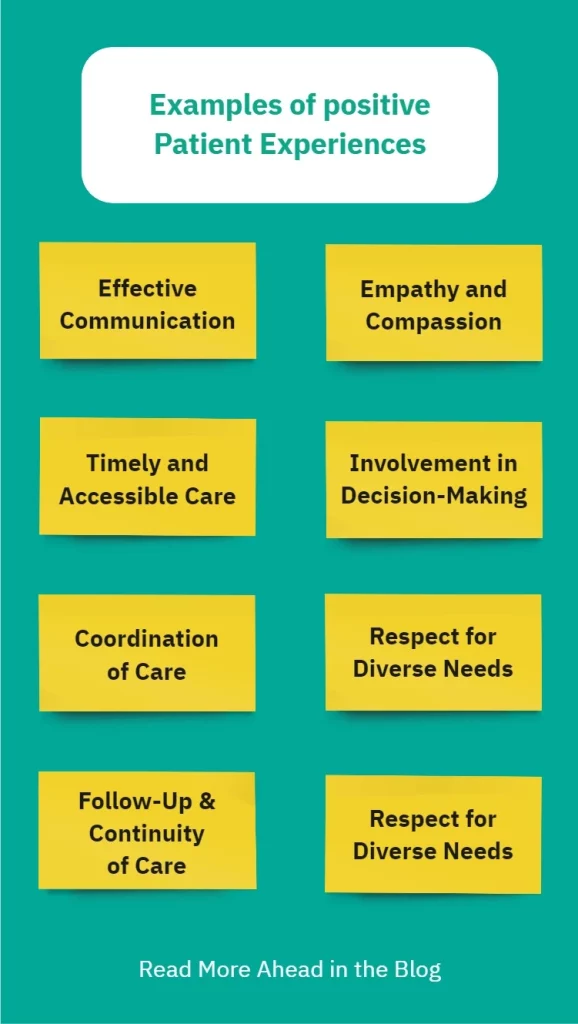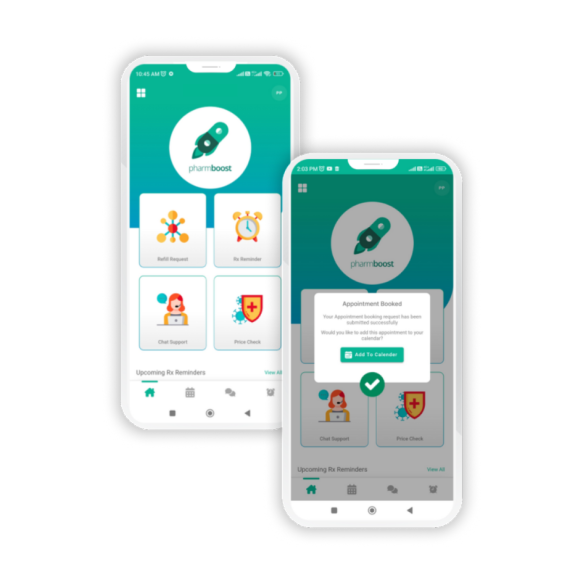February 5, 2024
Definition of patient experience in healthcare
Patient experience in healthcare refers to how patients perceive and feel about their interactions with the healthcare system. It includes communication, access to care, the quality of medical treatment, the environment, empathy, involvement in decision-making, and coordination of care. Positive patient experiences are associated with higher satisfaction, adherence to treatment, and better health outcomes. Healthcare organizations aim to improve patient experience through patient-centered initiatives and strategies.
Key components of patient experience include:
- Communication
- Access to Care
- Quality of Care
- Environment of healthcare facilities
- Empathy and Compassion
- Involvement in Decision-Making
- Coordination of Care
8 Reasons why is patient experience important
Patient experience is vital for several reasons:

1. Enhanced Patient Satisfaction
Positive patient experiences contribute to higher levels of satisfaction. When patients feel heard, respected, and involved in their care, it enhances their overall satisfaction with healthcare services.
2. Better Treatment Adherence
A positive patient experience is linked to increased adherence to treatment plans. Patients who have a good rapport with healthcare providers and understand their care are more likely to follow prescribed treatments, leading to better health outcomes.
3. Improved Health Outcomes
Positive patient experiences are associated with improved health outcomes. When patients have confidence in their healthcare providers and actively engage in their care, it can positively impact their recovery and overall well-being.
4. Increased Patient Engagement
A positive experience encourages patients to actively participate in their healthcare journey. Engaged patients are more likely to communicate openly with healthcare providers, ask questions, and collaborate in decision-making, fostering a sense of partnership in their care.
5. Effective Communication
Patient experience emphasizes effective communication between healthcare providers and patients. Clear communication ensures that patients understand their diagnosis, treatment options, and care plans, leading to informed decision-making.
6. Building Trust
Positive patient experiences contribute to the establishment of trust between patients and healthcare providers. Trust is a fundamental element in the patient-provider relationship and can lead to better communication, shared decision-making, and improved patient outcomes.
7. Enhanced Reputation for Healthcare Organizations
Organizations that prioritize positive patient experiences often build a strong reputation. Patients are more likely to recommend and return to healthcare facilities where they have had positive interactions, positively impacting the organization's standing in the community.
8. Prevention of Litigation
A positive patient experience can contribute to the prevention of legal issues. Patients who feel well-informed, respected, and involved in their care are less likely to pursue legal action, reducing the risk of malpractice claims.
In summary, patient experience is important because it not only influences the satisfaction of individuals seeking healthcare but also plays a significant role in treatment adherence, health outcomes, patient engagement, effective communication, trust-building, organizational reputation, and the prevention of legal complications.
12 Examples of positive Patient Experiences
Positive patient experiences can manifest in various ways throughout a healthcare journey. Here are some examples:

1. Effective Communication
2. Empathy and Compassion
3. Timely and Accessible Care
4. Involvement in Decision-Making
5. Coordination of Care
6. Respect for Diverse Needs
7. Follow-Up and Continuity of Care
8. Comfortable and Welcoming Environment
9. Patient Education
10. Effective Pain Management
11. Personalized Care Plans
12. Prompt Resolution of Issues
Positive patient experiences contribute to overall satisfaction, trust in healthcare providers, and better health outcomes. These examples highlight the importance of empathy, communication, coordination, and personalized care in creating a positive healthcare experience.
12 Ways to improve patient experience in your pharmacy
Improving patient experience in a pharmacy involves creating a welcoming environment, enhancing communication, and providing personalized and efficient services. Here are some ways to enhance the patient experience in your pharmacy:
1. Friendly and Knowledgeable Staff
- Ensure that staff members are approachable, friendly, and well-trained.
- Train staff to provide accurate and helpful information about medications, potential side effects, and proper usage.
2. Effective Communication
- Clearly communicate wait times, prescription pickup procedures, and any additional services offered.
- Encourage open communication, allowing patients to ask questions and express concerns.
3. Efficient Service
- Streamline processes to minimize wait times for prescription filling and checkout.
- Implement technologies such as online prescription refills or mobile apps to enhance convenience.
4. Patient Education
- Offer educational materials on medications, potential interactions, and proper usage.
- Take the time to discuss medication instructions and answer any questions patients may have.
5. Personalized Services
- Tailor services to meet individual patient needs, considering factors like language preferences, accessibility requirements, and specific health conditions.
- Consider implementing loyalty programs or personalized promotions to show appreciation for regular customers.
6. Comfortable Waiting Area
- Create a comfortable and welcoming waiting area with seating, reading materials, and possibly refreshments.
- Provide a private consultation area for more confidential discussions.
7. Follow-Up Services
- Implement a system for follow-up calls to check on patients' experiences and address any concerns.
- Offer medication therapy management services to help patients manage complex medication regimens.
8. Collaboration with Healthcare Providers
- Establish strong communication channels with healthcare providers to ensure accurate prescription information.
- Collaborate with prescribers to address any issues related to medication changes or adjustments.
9. Incorporate Technology
- Implement digital tools for prescription reminders, refill notifications, and online communication.
- Provide a user-friendly online platform for prescription refills and inquiries.
10. Continuous Training
- Regularly train staff on customer service skills, communication techniques, and the use of new technologies.
- Keep staff informed about new medications and healthcare trends.
11. Feedback Mechanism
- Establish a system for collecting feedback from patients about their experiences.
- Use feedback to identify areas for improvement and recognize staff for positive contributions.
12. Cultural Sensitivity
- Foster a culturally sensitive environment that respects the diverse needs and backgrounds of patients.
- Ensure that informational materials are available in multiple languages if necessary.
By focusing on these strategies, you can create a positive and patient-centered environment in your pharmacy, leading to improved patient satisfaction and loyalty. Regularly assess and adapt your approach based on patient feedback and changing healthcare trends.
How does Patient Engagement Software can help improve patient experience
Patient engagement software plays a crucial role in improving the overall patient experience by facilitating communication, providing access to information, and promoting active involvement in healthcare. Here are several ways in which patient engagement software contributes to enhancing the patient experience:
1. Communication and Information Sharing
- Secure Messaging: Patient engagement platforms often include secure messaging features, allowing direct communication between patients and healthcare providers. This facilitates timely and convenient communication for appointment reminders, follow-up care, and addressing concerns.
- Information Portals: Patients can access personalized health information, test results, and educational materials through online portals. This empowers patients to stay informed about their health and treatment plans.
2. Appointment Scheduling and Reminders
- Online Scheduling: Patient engagement software may include tools for online appointment scheduling, making it easier for patients to book appointments at their convenience.
- Automated Reminders: Automated appointment reminders via email, SMS, or push notifications help reduce no-show rates and improve overall appointment adherence.
3. Remote Monitoring and Telehealth
- Remote Patient Monitoring: Some patient engagement platforms support remote monitoring of chronic conditions. This enables healthcare providers to track patients' health metrics and intervene proactively when needed.
- Telehealth Integration: Integrating telehealth features allows patients to have virtual consultations, reducing the need for in-person visits and improving accessibility to care.
4. Medication Management
- Medication Reminders: Patient engagement tools often include features for medication reminders, helping patients adhere to prescribed medication regimens.
- Educational Resources: Patients can access information about their medications, including usage instructions, potential side effects, and interactions.
5. Health and Wellness Programs
- Interactive Programs: Patient engagement software may offer interactive health and wellness programs, encouraging patients to adopt healthy lifestyle habits and disease prevention strategies.
- Goal Setting and Tracking: Patients can set health goals, and the software helps them track progress, fostering a sense of empowerment and achievement.
6. Patient Surveys and Feedback
- Feedback Collection: Patient engagement platforms often include features for collecting patient feedback through surveys. This feedback helps healthcare providers assess and improve their services based on patient experiences.
- Quality Improvement: Analyzing patient feedback allows healthcare organizations to identify areas for improvement and implement changes to enhance the patient experience.
7. Care Plan Collaboration
- Collaborative Care Plans: Patient engagement tools facilitate the creation and sharing of care plans. Patients and healthcare providers can collaborate on these plans, promoting shared decision-making and active patient participation in their care.
8. Personalized Health Content
- Tailored Information: Patient engagement software can deliver personalized health content based on patients' specific conditions, preferences, and health goals. This ensures that information is relevant and meaningful to the individual patient.
By incorporating patient engagement software, healthcare providers can create a more interactive, patient-centered approach to care, leading to improved communication, better adherence to treatment plans, and ultimately enhancing the overall patient experience.
Pharmboost: Patient Engagement Software for Pharmacies in USA
Pharmboost is a HIPAA & ADA Compliant patient engagement solution designed for independent, community, and other pharmacies, stands out as a comprehensive solution. With a Mobile App catering to patients and a Web App tailored for pharmacies, it seamlessly integrates complete digital marketing strategies to propel pharmacy revenue growth. Not only does it equip pharmacy businesses with essential tools, but it also prioritizes patient satisfaction and care enhancement. Furthermore, Pharmboost supports pharmacies in retaining their patient base. Ready to elevate your patient engagement? request a demo today!
Pharmboost offers a comprehensive patient engagement solution designed to enhance your pharmacy’s online presence, Moreover, it also offers digital marketing services for your Pharmacy business.
- Definition of patient experience in healthcare
- 8 Reasons why is patient experience important
12 Examples of positive Patient Experiences- 12 Ways to improve patient experience in your pharmacy
- How does Patient Engagement Software can help improve patient experience
- Pharmboost: Patient Engagement Software for Pharmacies in USA
Recent Post
HIPAA Compliant Texting for secured Patient Engagement
Patient Satisfaction in Healthcare – Importance & practical ways to improve it
Patient Engagement in Healthcare: Stages & List of Activities
Online Appointments for your Pharmacy are a Key to Success







